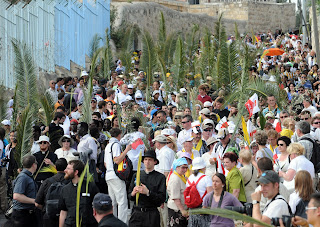On the day
that the Passover Lamb was traditionally selected, Jesus rode into Jerusalem on
a donkey. Spontaneously, the people along the road began to wave palm branches
and shout “Hosanna!” but what’s really going on might surprise you. First of
all, the people received Jesus as a prophet (Matt. 21:11) but not as the
Messiah.
This
event was prophesied in Zechariah 9:9:
“Rejoice greatly, Daughter Zion! Shout, Daughter Jerusalem! See, your king comes to you, righteous and victorious, lowly and riding on a donkey, on a colt, the foal of a donkey.”
The truth
is that the rest of that prophecy was about the Messiah coming as an agent of
peace:
“I will
take away the chariots from Ephraim and the warhorses from Jerusalem, and the
battle bow will be broken. He will proclaim peace to the nations. His rule will
extend from sea to sea and from the River to the ends of the earth.” (v. 10)
Notice
that Jesus weeps over the fact that they do not understand what his mission is
when he responds to their adulation and palm-waving with this statement:
“As he
approached Jerusalem and saw the city, he wept over it and said, “If you, even
you, had only known on this day what would bring you peace—but now it is hidden
from your eyes. The days will come upon you when your enemies will build an
embankment against you and encircle you and hem you in on every side. They will
dash you to the ground, you and the children within your walls. They will not
leave one stone on another, because you did not recognize the time of God’s
coming to you.” (Luke 19:41-44)
See, the
fact that they were waving palm branches is significant. Those palm branches
were a direct throwback to the Maccabean period when the triumphant Jewish
warriors rode into Jerusalem and the people celebrated their victory over the
Seleucids, which incidentally was followed immediately by a ritual cleansing of
the temple. At that time the people waved palm branches as a symbol of military
conquest over an oppressive enemy. By waving those palm branches, the people are
saying that they are ready for war. They are ready for the blood of the Romans
to be spilled in an uprising that they hope Jesus will lead them in. It’s no
different than when Peter cut off the servant’s ear in Gethsemane and received
the rebuke from Jesus.
Today we
usually read that passage about the people shouting “Hosanna!” as an indication
that the people received Jesus as their King. But on the contrary, the people
were rejecting Jesus as their personal, spiritual Messiah and calling out for
him to be their political, militant Messiah. When they shout “Hosanna!” which
means “Save us!” they are demanding him to lead the charge of attack against
the Romans.
This is
why Jesus weeps over the people. He knows that their hearts are far from God’s
heart. They want war. He has come to bring peace. They reject him and his
mission. They can’t receive him for who he is. They cannot submit to him as he
is – a humble servant riding on a donkey – they only want him to meet their
expectations for a warrior who will set them free from earthly oppression, but
they are unwilling to be set free from their own lusts and desires.
See, this was the day that the Passover Lamb was traditionally chosen to take away the sins of the people. On this day, the people rejected the Lamb because they wanted a Lion instead.
See, this was the day that the Passover Lamb was traditionally chosen to take away the sins of the people. On this day, the people rejected the Lamb because they wanted a Lion instead.
Ironically,
the people of Jerusalem would receive the very punishment they sought to bring
upon the Romans, as Jesus predicts in Luke 19:41-44, and later in Luke 21:5-38.
This is why Jesus weeps. He knows that in AD 70 the Romans will surround the
city and kill everyone and destroy the very temple he is about to go and
cleanse.
The
cleansing of the temple echoes the Maccabean cleansing roughly 200 years
before, but when Jesus cleanses the temple this time it is more than
ceremonial. Instead, he chases out the corrupt money changers and the sellers
of doves who were exploiting the poor, and he clears the floor that was
intended to be a place of prayer for the nations.
When you
wave a palm branch on Palm Sunday, you should know that it’s a symbol of
military power and conquest, not a symbol of humble devotion to the King who
rides on a donkey to reign as the Prince of Peace in every human heart.
-kg

3 comments:
Thanks Keith, this is a very different way of looking at those events in Judaea 2000 years ago.
We need to see almost everything about the church in a different way, we need to understand everything as the Almighty intends it, not as we might wish it!
A rather jaundiced way of interpreting Scripture.
I appreciate the (extremely!) different point of view here, but I would caution throwing out the palms with the bathwater. If I am to agree with your point of view on the original use of the palms, they were at best a misunderstanding of who Jesus was - the Prince of PEACE (instead of war). But can our current use of the palms symbolize exactly that - not a triumphant warlord king, but the Servant King?
And much as we have subverted the cross, the very symbol of terrible execution, to be for us a symbol of salvation, can we not, too subvert the palms into a sign of the Servant King?
Post a Comment